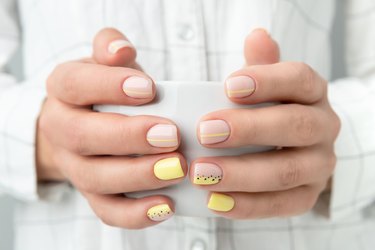
Hangnails are up there with the agony of hitting your funny bone and stubbing your toe. Except maybe they're worse because the discomfort can last for days.
A hangnail is when a piece of skin at the edge of your nail tears, according to the American Academy of Dermatology Association. They happen to the best of us, and this is probably not your first battle with them. So let's chat about what causes them, and maybe more importantly, how to treat and prevent hangnails.
Video of the Day
Video of the Day
What Causes Hangnails?
Hangnails are pretty common, especially in cold weather, Debra Jaliman, MD, a New York City-based dermatologist and author of Skin Rules, tells LIVESTRONG.com. "Your skin is prone to dryness in the cold, winter months. Dry, cracked skin can lead to hangnails," she says.
If you bite your nails, you're also more prone to developing hangnails.
What's more, because they create an irregular surface next to the nail, hangnails can get snagged on sweaters or caught on other material, pulled further and then bleed.
How to Get Rid of Hangnails
Let's start with what you should absolutely not do, Dr. Jaliman says: Pinch the hangnail with your pointer finger and thumb and try to rip it off. Or worse, bite it off with your teeth. You're probably likely to tear it more, which again, can cause bleeding.
Hangnails can become infected if they tear off, which allows bacteria and fungus a route into the skin. (This skin infection is called paronychia, per the U.S. National Library of Medicine.) So, it's worth it to take a few steps at home to treat a hangnail properly.
Dr. Jaliman recommends the following steps:
- Soak your hangnail in warm water to soften the nail.
- Clip off the hangnail with a clean cuticle scissor or nail clipper.
- Apply Aquaphor Healing Ointment or Vaseline onto the nail three times per day.
- Bandage the finger if it's painful. Bonus benefit: You can't pick at it if it's covered.
- Treat the nail with a thin layer of an over-the-counter antibiotic ointment (like Neosporin) if the skin around the nail appears red and/or irritated. Doing so will stop the growth of bacteria to help prevent infection.
If that's not enough, and — despite the prevention steps below — you get frequent or severe hangnails, then you can ask your dermatologist if they treat patients by applying surgical glue, suggests a November 2019 paper in the Journal of the American Academy of Dermatology. This adheres the skin so it won't tear deeper, and, say the authors, patients can go about daily tasks without worrying about pain or discomfort. Once healed, the hangnail will fall off. (But see your doc first before attempting this at home yourself.)
How to Prevent Hangnails
Of course, avoiding a hangnail in the first place is the ideal. Here's what to do, according to Dr. Jaliman:
- Keep hands and nails moisturized. "Don't just apply lotion or cream to your hands, also apply it to your nail beds and cuticles," she says.
- Cover up. If you're washing dishes or cleaning with chemicals, make sure to wear gloves.
- Keep hands dry. If you can help it, don't let your hands sit in water for an extended time.
Is this an emergency? If you are experiencing serious medical symptoms, please see the National Library of Medicine’s list of signs you need emergency medical attention or call 911.